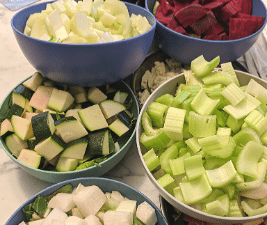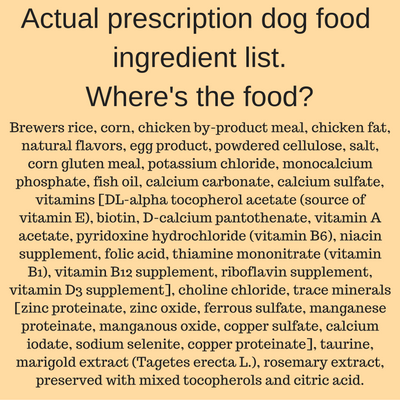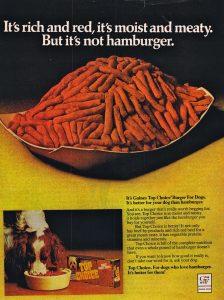Just as in packaged foods made for people, dog food ingredients are listed in order of most to least. If the first ingredient in your dog’s food isn’t actually food – chances are you should choose something else.
Everyone’s definition of food may be somewhat different. We like ingredients we recognize and can pronounce. And it probably shouldn’t be Brewer’s Rice or Corn Gluten Meal if it’s meant for our dogs.
Does this mean dogs should never get anything but health food? Of course not! We eat junk food occasionally. Our dogs can, too! Because we give our dogs lots and lots of “treats” while we’re training, most of them fall into the “healthy” category. But not always – they’re all familiar with the “magic window” at fast food joints.
We’re taking a look at some of the ingredients listed on actual dog food packages. These are listed alphabetically, instead of the label order.
Animal by-product Meal: rendered product from mammal tissues, exclusive of any added hair, hoof, horn, hide trimmings, manure, stomach and rumen contents except in such amounts as may occur unavoidably in good processing practices (AAFCO)
Animal Fat (Preserved With BHA And Citric Acid): animal fat is a crucial nutrient for dogs, but is subject to spoilage. Natural preservatives are okay – including those that are made from Vitamin C (ascorbates) or Vitamin E (tocopherols).
Ascorbic acid: Vitamin C – a naturally occurring organic compound with antioxidant properties
Aspergillus oryzae fermentation extract: a vegetal feed material obtained by the fermentation of Aspergillus Oryzae using particular nutrient substances (selected to optimise the ingredients in the final product) such as vegetable extracts
Beef meal: rendered product from mammal tissues, exclusive of any added blood, hair, hoof, horn, hide trimmings, manure, stomach and rumen contents except in such amounts as may occur unavoidably in good processing practices. It shall not contain extraneous materials not provided for by this definition.If the product bears a name descriptive of its kind, composition or origin it must correspond thereto.”
Beet pulp: the fibrous material left over after the sugar is extracted from sugar beets. It is supplied either as dried flakes or as compressed pellets
Beta carotene: Source of Vitamin A precursor, aids immune response, allergy control, slows aging
Bifidobacterium lactis: friendly bacteria often found in yogurt that is known to help stimulate immune responses
Biotin: a water-soluble B-vitamin (vitamin B7),
Bison: the clean flesh derived from slaughtered mammals and is limited to that part of the striate muscle which is skeletal or that part which is found in the tongue, in the diaphragm, in the heart or in the esophagus; with or without the accompanying and overlying fat and portions of the skin, sinew, nerve, and blood vessels which normally accompany the flesh. It shall be suitable for animal food. If it bears a name descriptive of its kind, it must correspond thereto.
Blueberries
Brewers Rice: the small milled fragments of rice kernels that have been separated from the larger kernels of milled rice. Brewers’ rice is a processed rice product that is missing many of the nutrients contained in whole ground rice and brown rice.
Calcium Iodate: A common food additive that is found in such products as dough and chicken feed.
Calcium Pantothenate: a water-soluble vitamin. Pantothenic acid is an essential nutrient. Animals require pantothenic acid to synthesize coenzyme-A(CoA), as well as to synthesize and metabolize proteins, carbohydrates, and fats.
Canola oil: a cultivar of rapeseed bred to be low in erucic acid
Carrots
Chia seed: source of Omega 3 fatty acids and fiber
Chicken meal: is the dry rendered product from a combination of clean flesh and skin with or without accompanying bone, derived from the parts or whole carcasses of poultry or a combination thereof, exclusive of feathers, heads, feet and entrails. It shall be suitable for use in animal food. If it bears a name descriptive of its kind, it must correspond thereto
Chicory Root: Around 1970, it was found that the root contains up to 20% inulin, a polysaccharide similar to starch. It is used as a sweetener in the food industry with a sweetening power 1⁄10 that of sucrose and is sometimes added to yogurts as a prebiotic. Inulin is also gaining popularity as a source of soluble dietary fiber and functional food.
Chicken fat: Good source of energy and flavor, preserved with Vitamin E and C
Choline Chloride: Almost all commercial pet foods contain supplemental choline, predominantly from choline chloride, a basic constituent of lecithin that is found in many plants and animal organs. It is important as a precursor of acetylcholine, as a methyl donor in various metabolic processes, and in lipid metabolism.
Cobalt Carbonate: A pinkish tan powder. It is a strong colorant and almost always produces blue in glazes. (We could find no reference other than as a pigment – not a food or supplement.)
Coconut
Color Added (Titanium dioxide, Yellow #5, Yellow #6, Red #40, Blue #2): All FDA approved color additives for use in food.
Copper Proteinate: chelated, organic and, better absorbed by the body.
Copper Sulfate: a common and effective copper source used in pet foods
Corn Gluten Meal: a byproduct of corn processing that has historically been used as an animal feed. It can also be used as an organic herbicide
Egg Product: eggs that are removed from their shells for processing at facilities called “breaker plants.” The processing of egg products includes breaking eggs, filtering, mixing, stabilizing, blending, pasteurizing, cooling, freezing or drying, and packaging
Enterococcus faecium: a Gram-positive, alpha-hemolytic or nonhemolytic bacterium in the genus Enterococcus. It can be commensal (innocuous, coexisting organism) in the human intestine, but it may also be pathogenic
Ferrous Sulfate: nutritional supplement used to prevent or treat low levels of iron in the blood.
Fish Meal: dry rendered product from a combination of clean flesh and skin with or without accompanying bone
Flaxseed: provides omega-3 fatty acids and nutritive fiber
Folic Acid: a B vitamin
Ground Yellow Corn: the whole grain of corn that has been ground. It contains the bran and the gluten together
Ground White Rice: Filler — has been linked to diabetes, always indicates white rice, not whole grain but usually floor sweepings from rice industry.
Iron Proteinate: a source of iron, which is chelated with amino acids to improve the bioavailability
Kale: leaf cabbage is a group of vegetable cultivars with multiple nutrients
Kelp (dried): seaweed, a source of minerals and amino acids, iodine, and fiber.
Lactobacillus acidophilus: a species of gram positive bacteria in the genus Lactobacillus. L. acidophilus is a homofermentative, microaerophilicspecies, fermenting sugars into lactic acid
Lactobacillus casei: a species of genus Lactobacillus found in the human intestine and mouth
Lactobacillus reuteri: probiotic bacteria that is found in the gut flora of some mammals and birds
Lamb meal: the rendered product from mammal tissues, exclusive of any added blood, hair, hoof, horn, hide trimmings, manure, stomach and rumen contents except in such amounts as may occur unavoidably in good processing practices. It shall not contain extraneous materials not provided for by this definition. If the product bears a name descriptive of its kind, composition or origin it must correspond thereto.”
Manganese Proteinate: Excellent source of manganese, nourishes the nerves and brain. Supports immune and enzyme functions
Manganese Sulfate: source of manganese
Manganous Oxide: a source of manganese, a mineral that has a vital role in the proper function of cells within the body. It is necessary for the formation of bone and joint cartilage and neurological function
Meat: the clean flesh derived from slaughtered mammals and is limited to that part of the striate muscle which is skeletal or that part which is found in the tongue, in the diaphragm, in the heart or in the esophagus; with or without the accompanying and overlying fat and portions of the skin, sinew, nerve, and blood vessels which normally accompany the flesh. Source: AAFCO)
Meat And Bone Meal: is the rendered product from mammal tissues, including bone, exclusive of any added blood, hair, hoof, horn, hide trimmings, manure, stomach and rumen contents except in such amounts as may occur unavoidably in good processing practices. It shall not contain extraneous materials not provided for by this definition (AAFCO)
Meat by-products: the non-rendered, clean parts, other than meat, derived from slaughtered mammals. It includes, but is not limited to, lungs, spleen, kidneys, brain, livers, blood, bone, partially de-fatted low temperature fatty tissue, and stomachs and intestines freed of their contents. It does not include hair, horns, teeth and hoofs. It shall be suitable for use in animal fee (AAFCO)
Meat Meal: rendered product from mammal tissues, exclusive of any added blood, hair, hoof, horn, hide trimmings, manure, stomach and rumen contents except in such amounts as may occur unavoidably in good processing practices (AAFCO)
Menadione Sodium Bisulfite Complex: a source of Vitamin K
Natural Flavor: unknown and dependent upon the individual manufacturer. Reportedly may include monosodium glutamate (MSG), or diacetyl
Niacin: a B vitamin
Ocean Fish Meal: a commercial product mostly made from fish that are not generally used for human consumption; a small portion is made from the bones and offal left over from processing fish used for human consumption. It is powder or cake obtained by drying the fish or fish trimmings, often after cooking, and then grinding it
Oranges
Papaya
Pearled Barley (cracked): nutritive grain
Pea Protein: source of vegetable based protein
Peas
Potassium Chloride: Potassium chloride is a source of potassium, which is a mineral that is essential for the correct functioning of cells in the body
Potassium iodide: use as a nutritional supplement in animal feeds and also the human diet
Potato
Potato fiber: filler ingredient
Poultry: clean combination of flesh and skin with or without accompanying bone, derived from the parts or whole carcasses of poultry or a combination thereof, exclusive of feathers, heads, feet and entrails (AAFCO)
Poultry By Products: non-rendered clean parts of carcasses of slaughtered poultry such as heads, feet, viscera, free from fecal content and foreign matter except in such trace amounts as might occur unavoidably in good factory practice (AAFCO)
Poultry By-Product Meal: consists of the ground, rendered clean parts of the carcasses of slaughtered poultry such as necks, feet, undeveloped eggs and intestines, exclusive of feathers except in such amounts as might occur unavoidably in good processing practices. (AAFCO)
Pumpkin
Pyridoxine Hydrochloride: vitamin B6, a B vitamin that has many roles in metabolism.
Quinoa: a seed, packed with nutrients including protein, amino acids, iron, magnesium, vitamin B12, antioxidants and fiber
Raspberries
Riboflavin Supplement: also known as vitamin B2
Rice Bran: filler
Saccharomyces cerevesiae fermentation soluble: brewery byproduct much like “grain fermentation solubles”, with some maltodextrin from malted barley
Salmon
Salmon Meal: powder or cake obtained by drying the fish or fish trimmings, often after cooking, and then grinding it. If the fish used is a fatty fish it is first pressed to extract most of the fish oil.
Salt: a combination of the two minerals sodium and chloride. Sodium is essential for healthy functioning of cells and maintains the acid base balance in the body with potassium. Chloride has a role in maintaining the fluid balance in the body and helps maintain acid base balance
Smoked Salmon
Sodium Selenite: a source of sodium and selenium. Sodium is essential for healthy functioning cells and maintains acid-base balance in the body with potassium. Selenium plays a vital role in reducing cellular damage caused by free radicals and a supportive role in immune response.
Soybean Meal: used in food and animal feeds, principally as a protein supplement, but also as a source of metabolizable energy. Some, but not all, soybean meal is produced from the residue left after oil extraction. Some, but not all, soybean meal contains ground soybean hulls
Spinach
Sweet Potato
Thiamine Mononitrate: synthetic form of vitamin B1
Tomato
Tomato Pomace: an inexpensive by-product of tomato manufacturing. Effectively, it is what is left over after processing tomatoes for juice, ketchup, soup, etc
Venison: the clean flesh derived from slaughtered mammals and is limited to that part of the striate muscle which is skeletal or that part which is found in the tongue, in the diaphragm, in the heart or in the esophagus; with or without the accompanying and overlying fat and portions of the skin, sinew, nerve, and blood vessels which normally accompany the flesh. It shall be suitable for animal food. If it bears a name descriptive of its kind, it must correspond thereto
Yucca Schidigera Extract: extracts from this plant are in animal feed and various herbal medications
Zinc Oxide: source of zinc, protects against free radicals, essential to insulin formation and immune function.
Zinc Proteinate: product resulting from the chelation of zinc with amino acids and/or partially hydrolyzed proteins. It is used as a nutritional animal feed supplement formulated to prevent and/or correct zinc deficiency in animals
Zinc Sulfate: source of zinc, protects against free radicals, essential to insulin formation and immune function.
Information sources:
NaturalNews.com – Report on pet food ingredients: http://www.naturalnews.com/Report_pet_food_ingredients_2.html
TruthAboutPetFood: http://truthaboutpetfood.com/
Dog Food Advisor: http://www.dogfoodadvisor.com/
AAFCO (Association of American Feed Control Officials) : http://www.aafco.org/
Feed Materials Register: http://www.feedmaterialsregister.eu/











